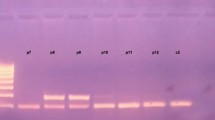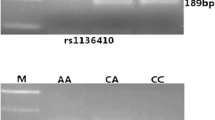Abstract
Background
Cryptorchidism is one of the most common congenital anomalies in newborn boys. There are various risk factors that have been verified to have relationship with cryptorchidism, including exogenous and genetic, but the pathogenesis of cryptorchidism remains unclear. PFKM gene is a critical gene encodes for a regulatory enzyme, which limits the rate in the pathway of glycolysis. We assumed that cryptorchidism risk may associated with PFKM gene single-nucleotide polymorphisms (SNPs). Thus we selected three tag SNPs in the PFKM gene and aimed to investigate the possible association between PFKM gene polymorphisms and cryptorchidism risk.
Methods
The SNPs were genotyped using polymerase chain reaction–restriction fragment length polymorphism (PCR–RFLP) analysis. 140 cases and 227 controls were enrolled in this study, including 105 unilateral cryptorchidism and 35 bilateral cases. The testis position was decided by the higher one in bilateral cases.
Results
The frequency of allele G of SNP rs2228500 is increased in cryptorchidism patients compared to that in controls (p < 0.05). Genotypic frequencies of rs2228500 are associated with the susceptibility of cryptorchidism in the codominant model (p < 0.05). And compared with G/G genotype in the dominant model, notable decreased frequencies of A carriers (A/G–A/A genotypes) were observed in cryptorchidism patients (p = 0.0069, OR = 1.80, 95% CI 1.17–2.75).
Conclusions
This research first revealed that PFKM gene polymorphisms were associated with cryptorchidism in a Chinese Han population. We have offered primary evidence that the G allele and the G/G genotype of rs2228500 SNP in the PFKM gene are more frequent in patients with cryptorchidism than healthy controls.
Similar content being viewed by others
References
Ghirri P, Ciulli C, Vuerich M, Cuttano A, Faraoni M, Guerrini L et al (2002) Incidence at birth and natural history of cryptorchidism: a study of 10,730 consecutive male infants. J Endocrinol Invest 25(8):709–715. https://doi.org/10.1007/BF03345105 (Epub 2002/09/21 PubMed PMID: 12240903)
Dieckmann KP, Pichlmeier U (2004) Clinical epidemiology of testicular germ cell tumors. World J Urol 22(1):2–14. https://doi.org/10.1007/s00345-004-0398-8 (Epub 2004/03/23 PubMed PMID: 15034740)
Lip SZ, Murchison LE, Cullis PS, Govan L, Carachi R (2013) A meta-analysis of the risk of boys with isolated cryptorchidism developing testicular cancer in later life. Arch Dis Child 98(1):20–26. https://doi.org/10.1136/archdischild-2012-302051 (Epub 2012/11/30 PubMed PMID: 23193201)
Kolon TF, Herndon CD, Baker LA, Baskin LS, Baxter CG, Cheng EY et al (2014) Evaluation and treatment of cryptorchidism: AUA guideline. J Urol 192(2):337–345. https://doi.org/10.1016/j.juro.2014.05.005 (Epub 2011/08/23, PubMed PMID: 24857650 PubMed PMID: 21855929)
Jensen MS, Olsen LH, Thulstrup AM, Bonde JP, Olsen J, Henriksen TB (2011) Age at cryptorchidism diagnosis and orchiopexy in Denmark: a population based study of 508,964 boys born from 1995 to 2009. J Urol 186(4 Suppl):1595–1600. https://doi.org/10.1016/j.juro.2011.03.070
Hutson JM (1985) A biphasic model for the hormonal control of testicular descent. Lancet 2(8452):419–421. https://doi.org/10.1016/s0140-6736(85)92739-4 (Epub 1985/08/24 PubMed PMID: 2863447)
Gurney JK, McGlynn KA, Stanley J, Merriman T, Signal V, Shaw C et al (2017) Risk factors for cryptorchidism. Nat Rev Urol 14(9):534–548. https://doi.org/10.1038/nrurol.2017.90 (Epub 2017/06/28 PubMed PMID: 28654092; PubMed Central PMCID: PMCPMC5815831)
Al Hasawi N, Alkandari MF, Luqmani YA (2014) Phosphofructokinase: a mediator of glycolytic flux in cancer progression. Crit Rev Oncol Hematol 92(3):312–321. https://doi.org/10.1016/j.critrevonc.2014.05.007 (Epub 2014/06/10, PubMed PMID: 24910089)
Dunaway GA, Kasten TP, Sebo T, Trapp R (1988) Analysis of the phosphofructokinase subunits and isoenzymes in human tissues. Biochem J 251(3):677–683. https://doi.org/10.1042/bj2510677 (Epub 1988/05/01, PubMed PMID: 2970843; PubMed Central PMCID: PMCPMC1149058)
Webb BA, Forouhar F, Szu FE, Seetharaman J, Tong L, Barber DL (2015) Structures of human phosphofructokinase-1 and atomic basis of cancer-associated mutations. Nature 523(7558):111–114. https://doi.org/10.1038/nature14405 (Epub 2015/05/20 PubMed PMID: 25985179)
Yi W, Clark PM, Mason DE, Keenan MC, Hill C, Goddard WA 3rd et al (2012) Phosphofructokinase 1 glycosylation regulates cell growth and metabolism. Science 337(6097):975–980. https://doi.org/10.1126/science.1222278 (Epub 2012/08/28, PubMed PMID: 22923583; PubMed Central PMCID: PMCPMC3534962)
Chen Y, Yu Q, Duan X, Wu W, Zeng G (2020) Phosphofructokinase-M inhibits cell growth via modulating the FOXO3 pathway in renal cell carcinoma cells. Biochem Biophys Res Commun 530(1):67–74. https://doi.org/10.1016/j.bbrc.2020.06.062 (Epub 2020/08/24, PubMed PMID: 32828317)
Lynn R, Gomes WR (1979) Phosphofructokinase in the rat testis during maturation and following heat treatment in vitro and in vivo. Biol Reprod 20(4):955–959. https://doi.org/10.1095/biolreprod20.4.955 (Epub 1979/05/01 PubMed PMID: 36934)
Lynn R, Gomes WR (1979) Phosphofructokinase in the rat testis: changes in isozyme patterns during maturation and short term cryptorchidism. Biol Reprod 20(4):961–964. https://doi.org/10.1095/biolreprod20.4.961 (Epub 1979/05/01 PubMed PMID: 36935)
Hutson JM, Hasthorpe S, Heyns CF (1997) Anatomical and functional aspects of testicular descent and cryptorchidism. Endocr Rev 18(2):259–280. https://doi.org/10.1210/edrv.18.2.0298 (Epub 1997/04/01, PubMed PMID: 9101140)
Scorer CG (1964) The descent of the testis. Arch Dis Child 39:605–609. https://doi.org/10.1136/adc.39.208.605 (Epub 1964/12/01 PubMed PMID: 14230757; PubMed Central PMCID: PMCPMC2019243)
Batra NV, DeMarco RT, Bayne CE (2021) A narrative review of the history and evidence-base for the timing of orchidopexy for cryptorchidism. J Pediatr Urol 17(2):239–245. https://doi.org/10.1016/j.jpurol.2021.01.013 (Epub 2021/02/09, PubMed PMID: 33551366)
Foresta C, Zuccarello D, Garolla A, Ferlin A (2008) Role of hormones, genes, and environment in human cryptorchidism. Endocr Rev 29(5):560–580. https://doi.org/10.1210/er.2007-0042 (Epub 2008/04/26, PubMed PMID: 18436703)
Hutson JM, Li R, Southwell BR, Newgreen D, Cousinery M (2015) Regulation of testicular descent. Pediatr Surg Int 31(4):317–325. https://doi.org/10.1007/s00383-015-3673-4 (Epub 2015/02/19 PubMed PMID: 25690562)
El Houate B, Rouba H, Sibai H, Barakat A, Chafik A, el Chadli B et al (2007) Novel mutations involving the INSL3 gene associated with cryptorchidism. J Urol 177(5):1947–1951. https://doi.org/10.1016/j.juro.2007.01.002 (Epub 2007/04/18, PubMed PMID: 17437853)
Ferlin A, Rocca MS, Vinanzi C, Ghezzi M, Di Nisio A, Foresta C (2015) Mutational screening of NR5A1 gene encoding steroidogenic factor 1 in cryptorchidism and male factor infertility and functional analysis of seven undescribed mutations. Fertil Steril 104(1):163–9 e1. https://doi.org/10.1016/j.fertnstert.2015.04.017 (Epub 2015/05/21, PubMed PMID: 25989977)
Bay K, Main KM, Toppari J, Skakkebaek NE (2011) Testicular descent INSL3, testosterone, genes and the intrauterine milieu. Nat Rev Urol 8(4):187–196. https://doi.org/10.1038/nrurol.2011.23 (Epub 2011/03/16, PubMed PMID: 21403659)
Fujii H, Miwa S (2000) Other erythrocyte enzyme deficiencies associated with non-haematological symptoms: phosphoglycerate kinase and phosphofructokinase deficiency. Baillieres Best Pract Res Clin Haematol 13(1):141–148. https://doi.org/10.1053/beha.1999.0062 (Epub 2000/08/05, PubMed PMID: 10916683)
Sun CM, Xiong DB, Yan Y, Geng J, Liu M, Yao XD (2016) Genetic alteration in phosphofructokinase family promotes growth of muscle-invasive bladder cancer. Int J Biol Markers 31(3):e286–e293. https://doi.org/10.5301/jbm.5000189 (Epub 2016/03/17, PubMed PMID: 26980488)
Ahsan H, Halpern J, Kibriya MG, Pierce BL, Tong L, Gamazon E et al (2014) A genome-wide association study of early-onset breast cancer identifies PFKM as a novel breast cancer gene and supports a common genetic spectrum for breast cancer at any age. Cancer Epidemiol Biomarkers Prev 23(4):658–669. https://doi.org/10.1158/1055-9965.EPI-13-0340 (Epub 2014/02/05, PubMed PMID: 24493630; PubMed Central PMCID: PMCPMC3990360)
Gao W, Huang M, Chen X, Chen J, Zou Z, Li L et al (2021) The role of S-nitrosylation of PFKM in regulation of glycolysis in ovarian cancer cells. Cell Death Dis 12(4):408. https://doi.org/10.1038/s41419-021-03681-0 (Epub 2021/04/17, PubMed PMID: 33859186; PubMed Central PMCID: PMCPMC8050300)
Villee CA (1984) Birth defects and glycolysis. N Engl J Med 310(4):254–255. https://doi.org/10.1056/NEJM198401263100408 (Epub 1984/01/26, PubMed PMID: 6690941)
Lee PA, Houk CP (2013) Cryptorchidism. Curr Opin Endocrinol Diabetes Obes 20(3):210–216. https://doi.org/10.1097/MED.0b013e32835ffc7d (Epub 2013/03/16, PubMed PMID: 23493040)
Barthold JS, Robbins A, Wang Y, Pugarelli J, Mateson A, Anand-Ivell R et al (2014) Cryptorchidism in the orl rat is associated with muscle patterning defects in the fetal gubernaculum and altered hormonal signaling. Biol Reprod 91(2):41 (Epub 2014/06/27, PubMed PMID: 24966393; PubMed Central PMCID: PMCPMC4435416)
Funding
This work was supported by the National Natural Science Foundation of China (No. 81974226, No.32171264, No.81974365) and Department of Science and Technology of Sichuan Province (No.2021YFS0026, No.2020ZYD007).
Author information
Authors and Affiliations
Contributions
Data collection and curation: SL, BZ, RZ; Formal analysis: SL; Investigation: SL, YS, Qy; Methodology: SL, RZ; Supervision: BZ, YW, ZL; Validation: ZL; Manuscript writing: All authors approved final version of the manuscript.
Corresponding authors
Ethics declarations
Conflict of interest
All authors declare that there is no conflict of interest regarding the publication of this paper.
Additional information
Publisher's Note
Springer Nature remains neutral with regard to jurisdictional claims in published maps and institutional affiliations.
Rights and permissions
About this article
Cite this article
Long, S., Zhang, R., Yang, Q. et al. Association of PFKM gene polymorphisms and susceptibility to cryptorchidism in a Chinese Han population. Pediatr Surg Int 38, 1311–1316 (2022). https://doi.org/10.1007/s00383-022-05167-2
Accepted:
Published:
Issue Date:
DOI: https://doi.org/10.1007/s00383-022-05167-2




